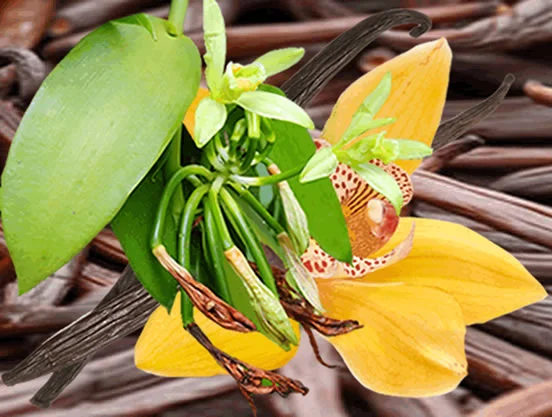Wholesale Vanilla Extra

1. Planting – Cross and hand pollinated to flower, they take a year to mature
2. Harvest – Odourless green pods are harvested after growing for 8 months
3. Modification (enzymatic) – Heating or freezing to prevent fermentation
4. Sun drying – To prevent decay and ready for transportation
From historic archives, the first data on vanilla dates back to fourteenth century, which is period when the Aztecs conquered the Totonacan empire in México. Spaniards took vanilla to Europe in 1519, when Hernán Cortés sent Francisco Montejo to Spain as bearer of the profits from the expedition, together with a number of novel products, including vanilla. In 1793 vanilla was taken to Paris botanical gardens, and then to England. In 1822 vanilla plants from France were sent to Reunion island from where this orchid was propagated through the Indian ocean countries including Madagascar, where the crop became an important source of income.
To get quality and sustainable yield, organic farming techniques need to be adopted with these points to remember. 1) Curing of green beans is to be commenced within a week of harvest. 2) Matured, light green with tinge of yellow-coloured beans is to be harvested individually, avoiding broom harvesting. 3) For heat killing, temperature of water should not exceed 65-70C. 4) Initial sweating is to be for 24 to 48 hours. Extension of this period will initiate rotting. Daily sun drying is to be followed by proper sweating for controlled fermentation. 5) The beans are to be examined every day during sun drying and slow drying for avoiding infection. 6) Moulds, if noticed, has to be removed from time to time. These beans are kept away from other beans. 7) As in the previous steps, beans are to be checked regularly, during conditioning too; to avoid any infection.
Vanilla interest in the world market increased availability for the natural product to face the competition by synthetic flavours as vanillin. Synthetic vanillin has been associated to cancer development. Also, natural vanilla contains many more flavour components than just vanillin. High demand for natural vanilla increased prices for the produce and prompted vanilla culturing in the rest of the world. Main vanilla producing countries currently are: Madagascar, Indonesia, China, México, and then others, which together supply most of the vanilla consumed in the world. Countries that cure vanilla and re-export the finished product make important profits without running risks associated with primary production.
After bean extraction, the vanilla pods are soaked in alcohol until they ferment into vanilla extract. In about three months we take the same pods and use them in our vanilla paste, this is what allows our vanilla products to be so cost effective. Our products are made from Vanilla Pods from which the beans have already been extracted. Our ingredients states the product is made from pulverized vanilla pods and bean extractives because there are still fragments of beans always left in pods. In order to add more flavour to our Madagascan vanilla extract, vanilla paste, and to ensure both excellent value for money and an original creamy and vanilla rich flavour, we use vanilla pods from Madagascan and mixed origin. Vanilla powder mix is spent ground vanilla pods otherwise known as exhausted vanilla powder that have previously been used in the production of vanilla extract.
